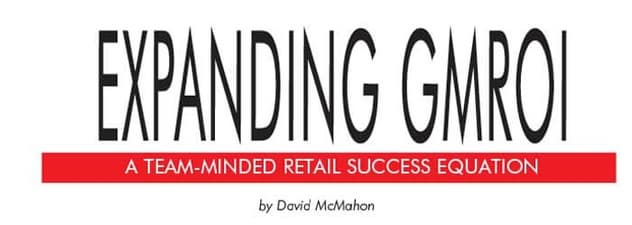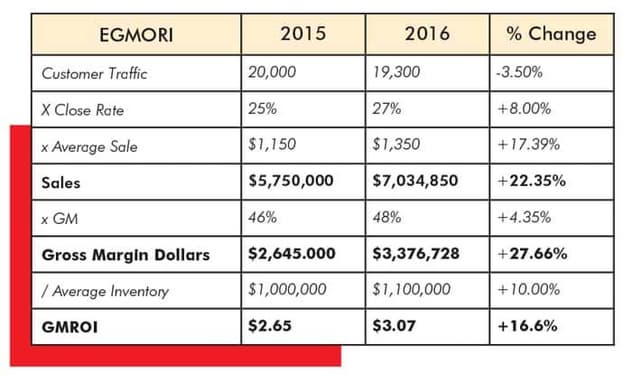
Here's how a furniture retailer used Expanded GMROI, a team approach, to grow GMROI 16% from 2015 to 2016.
Past issues of Furniture World, in this series of articles on financial management (see www.furninfo.com/Authors/David_McMahon/6) have explained how to use GMROI as a tool to improve Furniture World's readers' retail businesses. The traditional equation is yearly Gross Margin Dollars divided by inventory value.
GMROI = Annual Gross Margin Dollars / Average Inventory
There are multiple ways to grow gross margin dollars while keeping inventory dollars lean. This allows businesses to realize higher return on inventory investments. To review, some of these strategies include:
- Keep top selling, high margin items in stock a greater percentage of the time.
- Liquidate non-producing, low margin items fast.
- Maximize retail price points for best sellers.
- Incentivize sales team members to sell at higher margins.
- Maintain open to buy ranges for purchases of new merchandise.
- Track performance using the GMROI metric closely on vendors and categories.
The challenge inherent in using the traditional GMROI equation is that it does not point to where Margin Dollars come from. Furthermore, GMROI is not used, or even well understood, on the front lines of most retail businesses. This is a problem since Sales is one of the biggest factors that impacts performance. Growing sales at decent margin percentages, while keeping inventory lean, is the way to grow GMROI. That's why it's important to make an effort to really connect retail sales teams with GMROI.
With these challenges in mind I reworked the traditional GMROI metric, expanding the equation to help sales teams as well as inventory and operations teams to understand how their actions affect GMROI.
In the new equation, the gross margin numerator has been expanded to highlight where gross margin dollars come from. Gross margin comes from sales at a certain overall margin percentage. The expanded equation is:
Margin Dollars = Customer Traffic x Close Rate x Average Sale x GM %
Sales comes from a multiple of customer traffic, the conversion or close rate on that traffic and the average sale size of the transaction. The expanded equation for sales is:
Sales = Customer Traffic x Close Rate x Average Sale
Therefore, the Expanded Gross Margin Return on Inventory (EGMROI) equation is:
Expanded Gross Margin Return on Inventory (EGMROI) = (Customer Traffic x Close Rate x Average Sale x GM %) / Average Inventory
Here is a story of how adopting the expanded approach to GMROI (EGMROI) helped a furniture retailer, let's call them XYZ Furniture, in pursuit of a common goal of growing return on inventory.
Case Study
The owner of XYZ Furniture, a student of his business, had a complete understanding of GMROI at the top level. He also made sure that his inventory manager knew how to calculate her GMROI, how to report it, and how to put common strategies in place to improve it.
She was good at ordering best sellers and used a systematic markdown system to get rid of the store's dogs. The owner and buyer did the same things that seemed to work well to improve GMROI day-in-day out.
The problem was that GMROI stopped improving. The store's management team could not seem to figure out how to move the needle on GMROI forward with the same merchandising strategies that had been successful in past years. They were stuck.
The Sales Team
Interestingly enough, XYZ Furniture's Sales Manager had only a rudimentary understanding of GMROI. He said that he was not interested in this “Inventory Metric”. He was, however, interested in growing sales, believing that what was really needed was more inventory on the floor and more back up stock in the warehouse. With more inventory, his team could sell more by making deals with customers. The sales manager, therefore, trained his salespeople how to use discounting as a closing tool.
He did understand the sales equation well, and for the most part was motivated to improve average sale and close rate. But, because store traffic was declining, sales and margins were sluggish.
The Buyer
The buyer had only a rudimentary understanding of the sales equation and was not much interested in GMROI either.
The Owner
The Owner had decided that the jobs of improving GMROI and Sales were mutually exclusive tasks. He directed his buying and sales teams to “focus” on their separate areas of responsibility.
The result was that the buyer and sales teams were not working together to achieve the owner's goal. Furthermore, the operations staff at XYZ Furniture's distribution center was not connected to either the buyer or the sales team. Warehousing, delivery, customer service and administration had other performance metrics, but not a clue about what was happening with the store's GMROI or the selling equation.
GMROI Introduced
It became evident that in order to grow, there had to be a way to get the inventory, operations and selling teams working together. To advance this goal, EGMROI was introduced so that all the departments could use a single, coordinated performance measure. Expanded GMROI was introduced in the following way.
1. All department managers were called in to explain the performance metrics currently in use.
2. They were shown how the traditional GMROI equation works. If one area improves (for example if average inventory declines) and the other components of annual gross margin dollars remain constant, then GMROI improves.
3. Next, they were shown evidence that XYZ Furniture's GMROI had not improved over quite some time.
It became obvious that when one area of the company was going well, a problem would pop up in another area of the company, pulling them down as a team.
4. Finally, the teams were introduced to the expanded equation that they would now be required to live by:
Expanded Gross Margin Return on Inventory (EGMROI) = (Customer Traffic x Close Rate x Average Sale x GM %) / Average Inventory
The other operational metrics for departmental performance were kept in place. They just became secondary to the one primary metric of growing return on inventory using the expanded EGMROI formula. One metric to rule them all!
The Results
The needle started to move! GMROI, Sales, and Margin improved. It really is amazing what people can do together when working toward a clear and common goal.

In 2015, the multiple of 20,000 in traffic, a close rate of 25% and an average sale of $1,150 produced a topline volume of $5.75 Million. At a 46% Gross Margin they had $2.645 Million in Margin Dollars to pay for their operating costs and make a small profit. With $1.1 million in inventory held on average, their GMROI was $2.65. This meant that for every $1 invested in inventory, they made $2.65 cents (see chart above).
In 2016, traffic actually declined. However, the combination of increased close rates and average sales produced a 22% increase in volume. At the same time, XYZ Furniture managed to grow margins to 48% and produce almost a 28% increase in Gross Margin Dollars. Even though inventory increased by $100,000 on average due to more product flowing through the DC at any one time, their GMROI grew to $3.07-- over 16%. As you can imagine this produced subsequent jumps in both profitability and cash flow. After years of stagnation this business broke through to a new level.
The Final Word
I have always said that, “If something is worth improving, find a way to track it”. I’m now going to add: Make sure you track it with a common measure. Ensure teams understand that improving on what they do “together” is what really moves the needle forward.